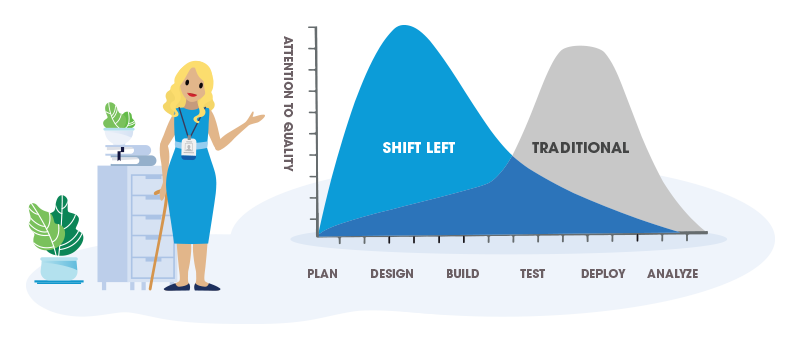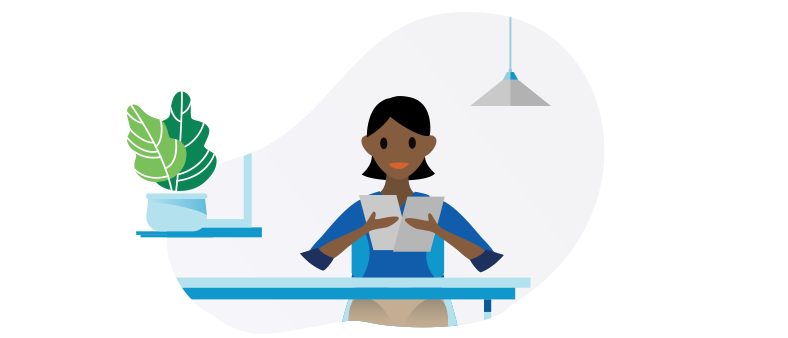Develop Accessible Hiring Policies
Learning Objectives
After completing this unit, you’ll be able to:
- Describe the difference between universal design and accommodations.
- Evaluate each stage of the hiring process and incorporate accessibility into each.
- Differentiate between implicit and explicit bias in hiring decisions.
Your organization might already be making strides in creating a more fair and welcoming culture. Your digital platforms may already align with Web Content Accessibility Guidelines (WCAG) for universal design. You might offer remote working options and focus on amplifying the voices of employees with disabilities. Your team might even celebrate National Disability Independence Day and Disability Employment Awareness Month.
These are all wonderful steps to take in creating a more accessible work environment, but what are you doing to foster disability equality from Day 1 of the hiring process?
In this module, you learn why designing your hiring process with disability equality in mind can help make your hiring process fair, objective, and accessible.
The Shift Left Mindset and Universal Design
You may have heard of the shift left approach as it relates to product design. The idea is that by considering accessibility at the beginning of the design process—or “shifting left” in the process—you prevent issues from coming up as much as possible and create a better product that works for everyone. This is also an important concept in accessible hiring practices. When you incorporate accessibility into your hiring initiatives from the start, you’ll be able to provide broader workplace adjustments to accommodate a wider range of needs, which, in turn, can attract a wider pool of applicants and include more people with disabilities.

The shift left mindset is closely related to the concepts of universal design and inclusive design. Both universal and inclusive design include proactive steps to creating fair and consistent experiences for everyone. In general, universal design is one-size-fits-all; the goal is to design one solution that serves all people with minimal adaptation. Inclusive design is one-size-fits-one. It’s all about relying on various and unique perspectives to recognize exclusive practices, solve them, and extend those benefits to all.
Still, no matter how universally designed a system may be, there is always the possibility that an individual will require an adjustment—called an accommodation in the U.S.—to perform effectively.
Let’s walk through each approach. By first understanding these concepts at a high level, you can apply them to your hiring efforts.
Approach |
Definition |
Examples |
|---|---|---|
Universal Design |
Designing products and environments to be usable by all people, to the greatest extent possible, without the need for adaptation. |
A sloped approach leading up to the main entrance, rather than stairs. Large, color contrasting fonts on signage and bulletin boards. |
Inclusive Design |
Designing solutions that offer a multitude of ways for people to participate in and contribute to an experience. The design process intentionally includes a variety of voices and perspectives. |
Captioning in a company’s promotional video. Curb-cut sidewalks. |
Accommodation |
An after-the-fact adjustment to a job or work environment that makes it possible for an individual with a disability to perform their job duties. Accommodations can include specialized equipment, modifications to the work environment, or adjustments to work schedules or responsibilities. |
An employee who is blind or low vision might need someone to read information posted on a bulletin board to them. An employee with diabetes may need regularly scheduled breaks during the workday to monitor their blood sugar and insulin levels. |
It’s important to note that not all people with disabilities—or even the same disability—need the same accommodation. For example, one job applicant who is deaf may request a sign language interpreter during the job interview, while another may not use sign language and prefer closed captioning instead. Each person’s experience is different, and it’s useful to understand what each person needs on an individual basis, rather than making assumptions.
The bottom line? Incorporating universal design through a shift left mindset can foster a more accessible environment. Remember that disabilities are as varied and unique as the people that have them. You may need to make accommodations or adjustments that enable individuals with disabilities to perform their jobs.
Equality Talent Principles Promote Accessibility
Too often, hiring managers recruit for resumes—not individuals. In reality, candidates are much more complex, nuanced, and talented than one piece of paper might show.
Anytime you’re hiring for a new position, it can be useful to keep your organization’s values and principles in mind. Salesforce maintains Equality Talent Principles for this very reason. They help ensure you’re recruiting the best candidate for the role, regardless of access needs. As you walk through each principle, consider this scenario to help analyze the importance of this process.
Scenario:
Amara and Tony are both applying for the same position at a marketing firm. They found the role on a common careers site. Both have relevant degrees and similar experience in the field. Their resumes have made it to the desk of the hiring manager, Kate, who is narrowing down the list of candidates who will be moved forward to the interview stage.

Equality Talent Principle 1: Enable Hiring Managers to Engage in Fair, Objective, and Consistent Decision-Making
Even hiring managers with the best intentions can struggle to hire with accessibility in mind if they don’t have the right tools. Make sure they have the education, resources, and leadership support to truly foster an accessible hiring process.
In the case of Amara and Tony, hopefully the hiring manager, Kate, has received training on identifying and mitigating biases in the hiring process. For instance, she might be more inclined to hire either Amara or Tony based on which one has experience, work history, or education that more closely aligns with her own background (something called Affinity Bias). If Kate is aware of how this, and other types of bias, show up in the hiring process, she may know enough to request that identifying information like names be removed before she receives the resumes.
Equality Talent Principle 2: Ensure Equal and Fair Treatment for Everyone
By taking a shift left mindset and considering multiple perspectives in the hiring process, you can ensure your process includes everyone from the start. As mentioned earlier, taking this proactive approach could prevent situations where unintentional bias or discrimination occur in the process.
In the Amara and Tony example, the hiring manager should make sure that all communications with candidates are accessible. Do important images in emails include alt text? Are all the videos shared with candidates captioned? If not, take action to ensure these considerations are in place.
Equality Talent Principle 3: Open and Create Equal Access to Reach Top Talent
At Salesforce, we recognize that having multiple perspectives present is what enriches our teams and ways of thinking. The broader the talent pool, the more access you have to candidates who can bring different and impactful perspectives, skills, and competencies to the team. A truly broad candidate pool increases the likelihood of you finding the most qualified candidate for the role and the team.
In Amara and Tony’s case, they both got access to the application through a common careers site. This suggests the hiring process was fairly open, although the company can also work with multiple organizations to source a wide variety of candidates.
Equality Talent Principle 4: Always Select the Most Qualified Candidate
The ultimate goal of recruiting is to find the most qualified candidate. That means looking beyond simple resumes in many cases, and seeking to understand an individual’s skills, competencies, and ability to execute. Unfortunately, biases toward people with disabilities still exist among hiring managers. We may not always be aware of our own biases, so be sure to consult your company’s hiring policy (or create one if it doesn’t exist) and use it to make fair, objective, and competency-based hiring decisions.
One way that biases can show up in the hiring process is when hiring managers make assumptions about candidates based on their name. In the case of Amara and Tony, a recent study from the National Bureau of Economic Research shows that Amara’s resume could possibly be evaluated differently from Tony’s, because her name indicates that she could be a woman. One way to avoid this type of bias entirely is to remove all names, addresses, and educational institutions from resumes before they are reviewed to reduce the likelihood of that information somehow influencing the recruiter or hiring manager’s decision unfairly.
Now that you know how our Equality Talent Principles promote accessibility in recruiting and hiring top talent, let’s talk about how you can design a hiring process to include your values and principles from the start.
Below are a few examples of how to turn principles into meaningful action. Please note that this is by no means an exhaustive list, but rather a foundation to help HR professionals augment their program design.
Step |
Best Practices to Increase Accessibility |
|---|---|
Post job to company website and various recruiting sites. |
|
Respond to qualified candidates via phone or email to set up an interview. |
|
Conduct interviews. |
|
Make offers. |
|
Sign contracts. |
|
Continue reading in the next unit as we explore ways to create an accessible onboarding experience for new hires.
Resources
- External Site: Web Accessibility In Mind: Alternative Text
- External Site: Inclusive Vs. Universal Design
- External Site: Universal Design and Accessibility
- External Site: Systemic Discrimination Among Large U.S. Employers
- Salesforce Blog: What Is ADA Compliance for the Web?
- External Site: Americans with Disabilities Act
- External Site: An Inclusive Interview Process
- External Site: Creating an Inclusive & Belonging Work Culture
- External Site: What Is The WCAG & How Does It Apply to You?